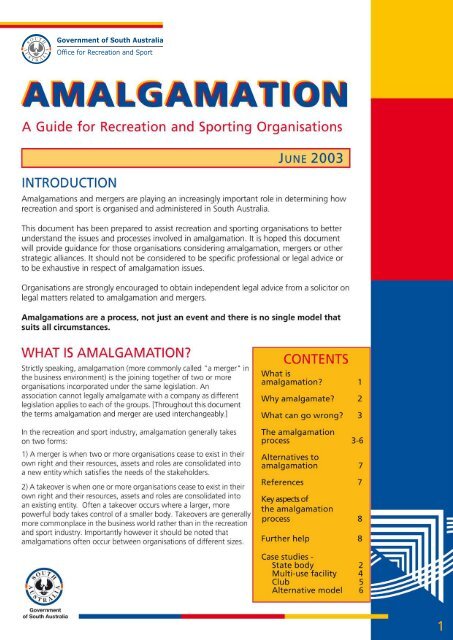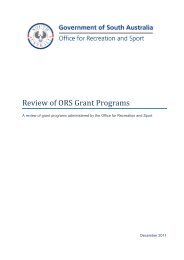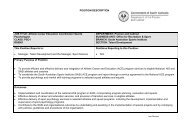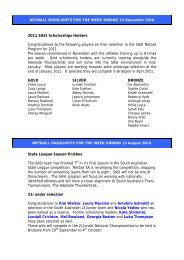Amalgamation - Office for Recreation and Sport
Amalgamation - Office for Recreation and Sport
Amalgamation - Office for Recreation and Sport
You also want an ePaper? Increase the reach of your titles
YUMPU automatically turns print PDFs into web optimized ePapers that Google loves.
WHY AMALGAMATE?<br />
The current recreation <strong>and</strong> sporting environment is one of change - with reduced access to sponsorship, a decreasing<br />
number of volunteers, population shifts, deregulated trading hours <strong>and</strong> greater accountability expected from funding<br />
bodies, all of which are impacting on the need to rationalise the number of organisations within a particular sport,<br />
facility or activity.<br />
In addition, inter national sporting bodies also seem to favour amalgamation in order to simplify their own<br />
communication processes with national bodies. For example prior to the Sydney 2000 Olympics, hockey's inter national<br />
gover ning body indicated that unless the Australian men's <strong>and</strong> women's associations amalgamated they would<br />
risk disaffiliation <strong>and</strong> both national teams would be ineligible to participate in the Games.*<br />
In many cases financial viability is a strong driver of amalgamation. The cost of insurance policies such as public<br />
liability, is one example where financial savings or economies of scale, may be achieved through amalgamation.<br />
On the positive side, many see that amalgamation can be a strategic way to grow their particular sport, facility or<br />
activity. This is particularly critical given both the increased dem<strong>and</strong>s of participants <strong>and</strong> accountability required by<br />
stakeholders.<br />
Organisations can no longer assume that their current structures, systems <strong>and</strong> practices are relevant <strong>and</strong> appropriate.<br />
Given the changing nature of the industry <strong>and</strong> a desire to deliver quality services <strong>and</strong> programs, many organisations<br />
are considering mergers <strong>and</strong> other types of cooperative arrangements such as <strong>for</strong>mal partnership agreements.<br />
In summar y, some of the benefits of amalgamation can include:<br />
• Increased marketing opportunities<br />
• Decreased costs through economies of scale<br />
• Development of a cohesive strategic approach<br />
• Simplified administration at club level<br />
• Spreading of risk<br />
• More effective allocation of resources<br />
• Increased quality or quantity of services<br />
• Improved government or corporate support<br />
CASE STUDY – TWO STATE BODIES<br />
The SA Gymnastic Association <strong>and</strong> the Kindergym Association of SA merged in early 1998 to <strong>for</strong>m<br />
“Gymnastics SA” after pressure from the national body (SA was the only state with a separate kindergym<br />
body) <strong>and</strong> funding bodies questioning why they should fund two organisations. A sub committee was set up<br />
with three persons from each Association who met monthly <strong>for</strong> approx 9-10 months. A <strong>for</strong>mal agreement<br />
was developed <strong>and</strong> signed by both organisations in July 1997 to progress the merger. A special<br />
general meeting was conducted at the end of 1997 with both Associations’ members voting on motions <strong>for</strong><br />
the merger to take place. On 31/12/1997 both old Associations were dissolved <strong>and</strong> the new organisation<br />
commenced on 1/1/1998.* In March 1998 both Associations held AGMs (in adjoining rooms) to receive final<br />
reports <strong>and</strong> financial statements, etc <strong>and</strong> then the first joint AGM of the new Association was conducted to<br />
appoint the new Board of Management. A new name, constitution <strong>and</strong> board <strong>for</strong>mat (5 directors) was<br />
developed <strong>for</strong> the amalgamated body. Some of the major issues that have arisen in the past five years include:<br />
• After 12 months, one of the non-negotiable requirements (a neutral office location) was no<br />
longer honoured.<br />
• Removal of the popular br<strong>and</strong> name “Kindergym SA” from the marketplace.<br />
Some of the barriers have included:<br />
• Unrealistic expectations that all kindergym members would then become part of the sport of gymnastics.<br />
• Kindergym being seen as a legitimate part of the gymnastic community.<br />
The major positive benefit of the merger is securing ongoing government funding.<br />
* Changes to legislation no longer require organisations to dissolve prior to amalgamation - see page 5 <strong>for</strong><br />
details of the process required.<br />
2 * from "How Hockey Avoided Merger Meltdown" by Sharon Phillips, Australian <strong>Sport</strong>s Commission, 2000
WHAT CAN GO WRONG WITH AMALGAMATION?<br />
One only has to look to the business world to see that not all mergers <strong>and</strong> takeovers are successful <strong>and</strong> many do fail.<br />
Mergers/amalgamations can be stressful - jobs <strong>and</strong> roles often change <strong>and</strong> programs are altered or discontinued.<br />
Considering strategies <strong>for</strong> managing change during this process is highly recommended.<br />
As each amalgamation is a unique, complex exercise, there will be a large range of issues that can arise. However the<br />
most common problem areas identified by amalgamated recreation <strong>and</strong> sporting bodies are:<br />
Financial – Ownership of assets <strong>and</strong> liabilities (particularly where there is a significant difference in financial positions),<br />
membership <strong>and</strong> capitation fees, how funds are brought into the new body <strong>and</strong> allocations are made to various<br />
programs <strong>and</strong> services, monitoring <strong>and</strong> accounting systems.<br />
Mistrust – This revolves around the idea that one organisation would dominate over the other <strong>and</strong> often includes<br />
clashes over facilities, access to resources, preservation of heritage <strong>and</strong> board representation.<br />
Equity – Lack of representation at decision-making level, access to facilities <strong>and</strong> resources <strong>and</strong> the transfer of existing<br />
life memberships <strong>and</strong> memorabilia such as honour boards <strong>and</strong> trophies are all sensitive issues.<br />
Boundaries – Definitions of regions or zones, structure <strong>and</strong> responsibilities <strong>for</strong> clubs or areas, particularly where there<br />
will be a reduction in numbers, is often a major area of conflict.<br />
Other issues that can arise <strong>and</strong> may affect the new organisation in a negative way include:<br />
• Loss of jobs due to more efficient use of human resources in a merged organisation.<br />
• Less flexibility to respond to requests from participants/clients due to larger size.<br />
• More st<strong>and</strong>ardised responses as part of a new structure.<br />
• Loss of volunteers or members.<br />
• Clashes of cultures – potentially different management styles or values of men's <strong>and</strong> women's groups.<br />
Moral <strong>and</strong> ethical issues<br />
Effective communication is the key in any successful relationship <strong>and</strong> an amalgamation between organisations is no<br />
different. The success of a merger can be totally dependent upon the development of good personal relationships<br />
between key people. Open <strong>and</strong> honest communication will help this develop.<br />
It would appear important to create a new organisation from scratch, without preconceived ideas, <strong>and</strong> based on a<br />
common vision. Keep asking - “What is best <strong>for</strong> the sport/activity/facility?” The new structure should build on the<br />
perceived strength of the individual partners in order to achieve an improved organisation. For this to occur, a level<br />
of trust must be established so that in<strong>for</strong>mation can be shared - all parties will need to review potentially sensitive<br />
administrative <strong>and</strong> financial records. It is important that these be treated in the strictest confidence, <strong>and</strong> there should<br />
be agreement about how far the in<strong>for</strong>mation can be disclosed (board/staff/members).<br />
Safeguards that ensure fairness <strong>and</strong> equity should be incorporated into the process <strong>and</strong> the new rules/constitution. The<br />
new organisation needs structures that both protect the rights of, <strong>and</strong> offer benefits to, all parties. This is particularly<br />
important as various parties may have had a strong loyalty to existing bodies <strong>and</strong> be reluctant to embrace the new one.<br />
THE AMALGAMATION PROCESS<br />
It is important to underst<strong>and</strong> that any amalgamation or merger is a living system that will evolve progressively. Again,<br />
amalgamations are a process, not just an event <strong>and</strong> there is no single model that suits all circumstances.<br />
The process is a lot like the stages in the development of a relationship between two people:<br />
• Courtship - commonalities <strong>and</strong> mutual needs are explored.<br />
• Planning - once a connection has been established, <strong>for</strong>mal plans start to be developed. This is often<br />
where lawyers <strong>and</strong> accountants become involved.<br />
• Commitment – the relationship is <strong>for</strong>malised <strong>and</strong> legally recognised.<br />
• Housekeeping - where both parties must learn to live together. Over time they develop new ways of<br />
working together as one.<br />
• Partnership - eventually as long-term partners they live com<strong>for</strong>tably <strong>and</strong> are changed internally.*<br />
Remember that whatever stage you are at, communication is critical – at every step – to all concerned. It is a good idea<br />
to use “track changes” in Word so people can be clear about what is changing with each redraft of any documents.<br />
The process outlined on the following pages may assist you to adapt to your own specific circumstances.<br />
* Adapted from "The Art of Alliances" by Rosabeth Moss Kanter<br />
3
STAGE ONE - SELF ANALYSIS<br />
This is the courtship stage where you need to find out about yourself <strong>and</strong> your prospective partners.<br />
Identify the reasons <strong>for</strong> amalgamation. This might include the possible benefits, but you might also identify concer ns.<br />
Once you have identified potential partners – conduct a compatibility check. Compare objectives, structures, systems,<br />
culture, assets, income <strong>and</strong> expenses. Look <strong>for</strong> common ground, as well as areas of strength <strong>and</strong> weakness. When<br />
there is agreement that amalgamation is desired, then it is advisable to develop a pre-merger, cooperative<br />
arrangement. This is where the parties resolve to act cooperatively on all matters of mutual interest <strong>and</strong> benefit. In<br />
addition resources (financial <strong>and</strong> human) should be allocated to the amalgamation process.<br />
STAGE TWO - PREPARATION & PLANNING<br />
This stage is where you start to plan how best to <strong>for</strong>malise the relationship.<br />
Establish an independent task <strong>for</strong>ce or committee to oversee the amalgamation process. You need to think carefully<br />
about the composition of this committee to ensure there is adequate representation from all parties <strong>and</strong> sufficient<br />
expertise to complete the task. The terms of reference (responsibilities <strong>and</strong> limitation of powers) <strong>for</strong> the committee<br />
should clearly state the required outcomes. It is best to appoint an independent chair that has no allegiance to any<br />
of the proposed partners in the amalgamation. Develop a shared vision <strong>and</strong>/or principles that should underpin any<br />
proposed amalgamation. This provides the point of reference <strong>for</strong> the task <strong>for</strong>ce.<br />
The role of the task <strong>for</strong>ce should be to:<br />
1. Review the background <strong>and</strong> history of each organisation.<br />
2. Compare the constitution <strong>and</strong> by-laws of all parties.<br />
3. Receive proposals <strong>for</strong> the new amalgamated body from each organisation involved.<br />
4. Make recommendations covering the following areas:<br />
› Governance (including voting rights, advisory/st<strong>and</strong>ing committees, representation<br />
<strong>and</strong> board composition)<br />
› Organisation name <strong>and</strong> structure (boundaries/regions/clubs/members)<br />
› Staffing (paid & volunteer)<br />
› Programs <strong>and</strong> services (including events <strong>and</strong> competitions, Technical/High per<strong>for</strong>mance)<br />
› Administration (due diligence enquiries)<br />
› Finance (including fees <strong>and</strong> levies, sponsorship, assets)<br />
› Facilities usage, location <strong>and</strong> ownership<br />
› Promotion <strong>and</strong> marketing<br />
› Process <strong>for</strong> implementation including legal requirements<br />
› Equity<br />
› Memorabilia <strong>and</strong> life membership<br />
› Transition issues<br />
› Time line <strong>for</strong> implementation<br />
Allow time <strong>for</strong> discussion <strong>and</strong> feedback on the task<strong>for</strong>ce recommendations <strong>for</strong> the proposed new organisation.<br />
Consultation with all stakeholders (which may include gover nment <strong>and</strong> state or national bodies) as well as members<br />
is important to avoid issues later on that could derail the amalgamation process.<br />
CASE STUDY – MULTI-USE FACILITY<br />
The Cove <strong>Sport</strong>s <strong>and</strong> Community Club was incorporated in 1994, but never really functioned effectively as an<br />
overall management support body <strong>for</strong> the eight clubs located there. Other issues such as financial sustainability<br />
<strong>and</strong> operational efficiency also drove the <strong>for</strong>mation of a new amalgamated structure.<br />
The process was a 12-month project that also saw the Cove <strong>Sport</strong>s <strong>and</strong> Community Club change its image from<br />
traditional, smoky, sports clubrooms to a smoke-free centre connecting to all sectors of the community.<br />
The City of Marion played a facilitator role with the clubs embracing the concept <strong>for</strong> a new 'management<br />
group/committee' taking ultimate control. In February 2003 the incorporated body made some constitutional<br />
changes <strong>and</strong> <strong>for</strong>med a management committee made up of local business people, community members <strong>and</strong><br />
some representation from the clubs.<br />
4<br />
Some of the barriers included some negative response due to the project needing to overcome some difficult<br />
hurdles (financial, mistrust <strong>and</strong> lack of confidence that the complex would achieve goals). A major issue has<br />
been the re-imaging of the complex as a leisure club that responds to the leisure consumer, yet still balancing<br />
the needs of traditional, structured sports such as football, cricket <strong>and</strong> netball. Positive outcomes have included<br />
increased community ownership of the whole facility with a focus towards self-sufficiency.
STAGE THREE – COMMITMENT<br />
This is when the relationship is <strong>for</strong>malised legally once you have agreed on the way <strong>for</strong>ward.<br />
Once the decision to amalgamate is taken it is suggested you <strong>for</strong>malise this by all parties signing a Memor<strong>and</strong>um<br />
of Underst<strong>and</strong>ing (MOU). This document is evidence of the parties' intentions <strong>and</strong> records important details such as<br />
the basic terms <strong>and</strong> conditions. After this an implementation plan will need to be developed to cover aspects such as:<br />
• Legal issues - Constitution, name, resolutions to create new body <strong>and</strong> wind up existing groups, notification<br />
to the <strong>Office</strong> of Consumer <strong>and</strong> Business Affairs (OCBA).<br />
• Financial issues - Budget, accounting system, bank accounts, pre-amalgamation transactions, finalising<br />
contracts.<br />
• Gover nance issues - Transitional board, voting rights, board functions, advisory committees, equity issues.<br />
• Management <strong>and</strong> staffing issues - Location, industrial issues, staff requirements, transitional arrangements,<br />
human resource policy <strong>and</strong> procedures.<br />
• T imeline issues - Deadlines <strong>and</strong> issues to be addressed prior to merge, <strong>and</strong> after incorporation of new body.<br />
In order to amalgamate two or more incorporated associations, a special resolution is needed of their respective members<br />
to resolve to <strong>for</strong>m a new association. An application <strong>for</strong> amalgamation must also be made on the appropriate <strong>for</strong>ms<br />
from the <strong>Office</strong> of Consumer <strong>and</strong> Business Affairs. These include "Form 4 - Application <strong>for</strong> <strong>Amalgamation</strong>" which<br />
must be accompanied by the completed "Checklist <strong>for</strong> the Proposed Rules of an Association" <strong>for</strong>m. A fee is also payable<br />
to OCBA. Lodgement must be made within one month of the earliest resolution passed by the amalgamating associations<br />
otherwise late fees can apply.<br />
In addition to the documents referred to in Form 4, the Certificate of Incorporation of the amalgamating associations<br />
must accompany the applications. If lost, an appropriate statement should be given in writing. One of the documents<br />
referred to in Form 4 is Rules of the Proposed Amalgamated Association. These rules must be typed on single<br />
sheets of A4 white paper. The Public <strong>Office</strong>rs of both (or all) the amalgamating associations are required to sign the<br />
application. All debts, liabilities <strong>and</strong> property of the incorporated associations being amalgamated transfer across to<br />
the newly amalgamated body, unless there are specific provisions to deal with them in some other legally accepted<br />
way. T ime will need to be allowed to establish new bank accounts <strong>for</strong> the amalgamated association <strong>and</strong> finalise<br />
existing accounts prior to closing them off.<br />
If both organisations have an Australian Business Number (ABN) <strong>and</strong>/or are registered <strong>for</strong> Goods <strong>and</strong> Services Tax (GST),<br />
the following process needs to occur:<br />
• Once the amalgamated association is a new legal entity, an application should be made <strong>for</strong> an ABN <strong>and</strong> to<br />
register <strong>for</strong> GST (if required). This can take about 28 days, however applications over the internet may be able<br />
to obtain an ABN much quicker.<br />
• The two parties to the amalgamation should finalise outst<strong>and</strong>ing income tax instalments, GST payments <strong>and</strong><br />
Business Activity Statements (BAS) BEFORE cancelling their individual ABN <strong>and</strong> GST registrations. Application to the<br />
Australian Taxation <strong>Office</strong> (ATO) must be made on the appropriate <strong>for</strong>m.<br />
It is recommended you seek independent legal advice on the process of amalgamation.<br />
Don’t <strong>for</strong>get to celebrate the winding up of the old <strong>and</strong> commencement of the new organisation. It is important to<br />
honour the contributions of those people who have created <strong>and</strong> developed the original associations. One suggestion<br />
is to create an “Honour Roll” that includes a set number of nominees from all original bodies - with the names <strong>and</strong><br />
original organisations listed on a plaque that can then be displayed prominently in the home of the new body.<br />
CASE STUDY – CLUB<br />
The Brighton <strong>and</strong> Seacliff Hockey Clubs were located close together, with each having advantages the other didn't<br />
(one had strong membership <strong>and</strong> Premier League status, the other facilities with a new artificial playing surface).<br />
Financial viability would have been an issue <strong>for</strong> both clubs if they continued to operate separately.<br />
Meetings between clubs, in addition to separate meetings of each club's members, occurred during 1994 resulting<br />
in various constitution drafts <strong>and</strong> planning proposals. The final constitution included provision <strong>for</strong> an inaugural<br />
committee with equal membership from each parent club <strong>and</strong> the future management structure. This was followed<br />
by a final combined "vote" meeting, allowing amalgamation to occur in 1995.<br />
Both club management committees, along with strong support from Council <strong>and</strong> the state peak body drove the<br />
process to create one strong club with long-term viability. Club uni<strong>for</strong>ms were an issue, along with change of<br />
traditional colours, new fee structures, differences over the new club’s name, cultural differences – one club being<br />
elite player oriented, the other more socially oriented, <strong>and</strong> there was some loss of members from both sides.<br />
However, since amalgamation there has been growth in membership (exceeding that of the two parent bodies)<br />
<strong>and</strong> a stronger volunteer base to ensure long-term viability of the club.<br />
5
STAGE FOUR - INTEGRATION<br />
Once the <strong>for</strong>mal processes have been completed, the post-amalgamation integration begins where all<br />
parties have to learn how to work together in a new structure.<br />
Often this is the stage when mergers can fail, despite all the best planning. During this transition stage it is easy to<br />
get bogged down with minor issues <strong>and</strong> lose sight of the big picture - the reason you amalgamated in the first place.<br />
Remember the shared vision developed in stage 2?<br />
There are three areas of action that are critical during this stage:<br />
1. Obtaining buy-in, which simply means getting people on side <strong>and</strong> supporting the new organisation. This<br />
needs to happen as early as possible.<br />
2. Clear orientation, everyone needs to be well in<strong>for</strong>med <strong>and</strong> have clear direction in order to support the vision<br />
of the amalgamation.<br />
3. Expectations (both inter nal <strong>and</strong> exter nal) need to be managed in a proactive way. Open <strong>and</strong> honest<br />
in<strong>for</strong>mation needs to be provided up front <strong>and</strong> continue as the integration process progresses.<br />
To give any amalgamation the best chance of success, here are six key factors you need to consider.*<br />
1) Vision - It is important to remember that the new organisation should be modified to fit the vision, rather than<br />
trying to make the vision fit the organisation. It may help to develop a business plan <strong>for</strong> the new organisation <strong>and</strong><br />
then determine operational structures. Your vision should be clear <strong>and</strong> realistic so it is easily understood.<br />
2) Leadership - Should be an urgent priority. Someone needs to take control <strong>and</strong> quickly. Both the president/chair <strong>and</strong><br />
key staff should have been identified at the time, or prior to the amalgamation taking place. Otherwise uncertainty<br />
<strong>and</strong> anxiety will grow, <strong>and</strong> power struggles can destroy goodwill on both sides.<br />
3) Focus on growth - Rather than cost cutting. Opportunities should follow from the vision <strong>and</strong> business plan of the new<br />
organisation. Efficiency savings may well be taken up by the costs of implementing the amalgamation in the early stages.<br />
4) Positive action - Try to get some early wins on the board - these should be actual achievements <strong>and</strong> not just words.<br />
Work out whether your priority is internal (staff) or external (stakeholders/clients).<br />
5) Communication - Lack of commitment is the biggest barrier to successful integration, whereas effective<br />
communication will persuade people to believe in the vision <strong>and</strong> act to make it happen. Leaders in the new organisation<br />
need to determine their communication goals <strong>and</strong> plan their strategy carefully.<br />
6) Organisational integration - Assess the differences between the amalgamating organisations (assumptions,<br />
rules <strong>and</strong> the way things are done). Decide whether you will adopt one culture or preferably create a joint culture,<br />
which takes the best from the individual partners. You need to set up a system of incentives <strong>and</strong> penalties to rein<strong>for</strong>ce<br />
the new culture. Underst<strong>and</strong> that it will take time <strong>for</strong> people to adjust.<br />
CASE STUDY – ALTERNATIVE TO AMALGAMATION<br />
Historically soccer has developed a number of controlling bodies each looking after a different part of the sport.<br />
Over time this has led to duplication of activity <strong>and</strong> resources <strong>and</strong> difficulties in gaining funding or sponsorship.<br />
Whilst there has been support from government <strong>and</strong> other agencies <strong>for</strong> a peak body, the process has been driven<br />
by the soccer community to address these issues <strong>and</strong> attempt to repair the public perception <strong>and</strong> media profile<br />
of soccer in South Australia.<br />
Discussions about a peak body started over four years ago with initial meetings of representatives from various<br />
soccer bodies, chaired by an independent, high profile, soccer identity. The outcome was that four key soccer<br />
organisations (South Australian Soccer Federation, South Australian Amateur Soccer League, South Australian<br />
Junior Soccer Association <strong>and</strong> South Australian Women’s Soccer Association) <strong>for</strong>med a new body - ‘Soccer SA’.<br />
Initially, all four partners retain incorporation <strong>and</strong> control of their own affairs, but have agreed to work together<br />
on particular elements of business (namely sponsorship <strong>and</strong> marketing, common registration database <strong>and</strong> better<br />
coordination of events <strong>and</strong> fixtures). The SA Soccer Federation retains its status as the member to the national<br />
body, but must consult with the other partners on any decisions to be taken. The arrangement is detailed in a<br />
Memor<strong>and</strong>um of Underst<strong>and</strong>ing signed by all partners in December 2002 <strong>for</strong> a one-year period. Following the<br />
signing of the MOU, an independent chair was nominated <strong>and</strong> endorsed by the partners.<br />
6<br />
It has taken time to build trust amongst the group, share commercial in confidence in<strong>for</strong>mation <strong>and</strong> put aside<br />
the history between many of the partners. Whilst work has begun on a number of projects (common database,<br />
sponsorship) progress has been hampered by the upheaval in soccer at a national level. At the end of the MOU<br />
term, a more lasting arrangement is envisaged which includes the development of a business plan <strong>and</strong><br />
incorporation of Soccer SA. Whilst there are still issues to be resolved, the parties are now sitting around the<br />
table, with a <strong>for</strong>mal agreement outlining how they can work together, discussing their collective future.<br />
* Adapted from "After the Merger" by Habeck, Kröger <strong>and</strong> Träm.
ALTERNATIVES TO AMALGAMATION<br />
Total integration of separate bodies (particularly men’s <strong>and</strong> women’s sporting groups) may not provide the best<br />
outcomes <strong>for</strong> all concerned <strong>and</strong> other options may be more appropriate. For example a structure may be developed<br />
that allows <strong>for</strong> funding, insurance <strong>and</strong> corporate identification to be h<strong>and</strong>led by a joint committee, whilst leaving<br />
separate bodies to manage participation development, program <strong>and</strong> competition management. A Memor<strong>and</strong>um of<br />
Underst<strong>and</strong>ing could be developed to <strong>for</strong>malise the functions <strong>and</strong> tasks to be managed jointly.<br />
An auspicing or partnership agreement may also allow <strong>for</strong> a smaller group to operate independently, but exist legally<br />
under the banner of a larger organisation. This may be suitable in the case of the management of specific activities or in<br />
the sharing of a facility.<br />
These options should be considered when looking at the functions <strong>and</strong> roles of each body <strong>and</strong> determining the best<br />
structure to achieve the desired outcomes. A final solution that has aspects of both integration <strong>and</strong> separation may<br />
well be the best model <strong>for</strong> some clubs or associations.<br />
The case studies also provide examples of some different structures that organisations have used to operate effectively.<br />
SUMMARY<br />
It is possible to create successful amalgamations in the sport <strong>and</strong> recreation industry, but they require careful planning,<br />
negotiation <strong>and</strong> a willingness to keep an open mind about the final outcome.<br />
Strong leadership is required <strong>and</strong> also an underst<strong>and</strong>ing that some people will need to take a backseat.<br />
The time it takes will vary according to the commitment, resources <strong>and</strong> unique requirements of the organisations<br />
involved. It is common <strong>for</strong> the process to take a year or more to allow adequate time <strong>for</strong> discussion, debate <strong>and</strong><br />
planning. T imelines should be set, <strong>and</strong> followed wherever possible to keep the process moving. Drawn out processes<br />
result in lost momentum <strong>and</strong> make it harder to gain commitment <strong>and</strong> support.<br />
<strong>Amalgamation</strong> should not be seen as the answer to financial <strong>and</strong> operational difficulties - even the best planned<br />
mergers can fail due to exter nal pressures <strong>and</strong> un<strong>for</strong>eseen circumstances.<br />
In the case where there are “take-overs” by larger, more powerful organisations, or mergers where a large body<br />
unites with a smaller one, it should not be assumed that the larger body's ways of operating should be adopted<br />
automatically. It is important to take an approach which adopts the best practices of both organisations. To avoid<br />
disputes <strong>and</strong> disappointment, careful thought will need to be given to ways of providing a voice <strong>for</strong> the smaller<br />
organisation in future decision making.<br />
Only where there is full commitment on both sides will the arrangement last long enough to be successful <strong>and</strong> create<br />
value <strong>for</strong> all the partners involved. Successful amalgamations are the result of honest self-analysis, chemistry <strong>and</strong><br />
compatibility. The best results come from people who believe in the outcome, have a shared vision <strong>and</strong> a philosophy<br />
of creating a new organisation that takes the best from all the individual partners.<br />
References:<br />
Australian <strong>Sport</strong>s Commission <strong>Amalgamation</strong> of National <strong>Sport</strong>ing Organisation Guidelines, 1997<br />
Brown, S <strong>and</strong> Reid, H “For Better or Worse – <strong>Amalgamation</strong> of Men’s <strong>and</strong> Women’s <strong>Sport</strong>ing Bodies”, Australian Leisure<br />
Management Journal, April/May pp52 –54, 1999<br />
Habeck, M. Kröger,F. <strong>and</strong> Träm, M. "After the Merger – Seven Rules <strong>for</strong> Successful Post-merger Integration", Pearson<br />
Education Limited, Great Britain, 2000<br />
MacKay, Janet "An Investigation into the <strong>Amalgamation</strong> of <strong>Sport</strong>ing Bodies" prepared <strong>for</strong> Women’s Golf New Zeal<strong>and</strong>,<br />
July 2002<br />
Moss Kanter, Rosabeth "The Art of Alliances", Harvard Business Review on Strategic Alliances, Harvard Business Publishing<br />
Corporation, USA, 2002<br />
Phillips, Sharon "How Hockey Avoided Merger Meltdown", Australian <strong>Sport</strong>s Commission, 2000<br />
Saul, Jeff "The Impact of Gender Equity Issues on the Structures of <strong>Sport</strong>ing Organisations: A Case Study of Women’s<br />
<strong>Sport</strong> in Australia", Masters of Management Dissertation, University of Technology, Sydney 2001.<br />
7

















